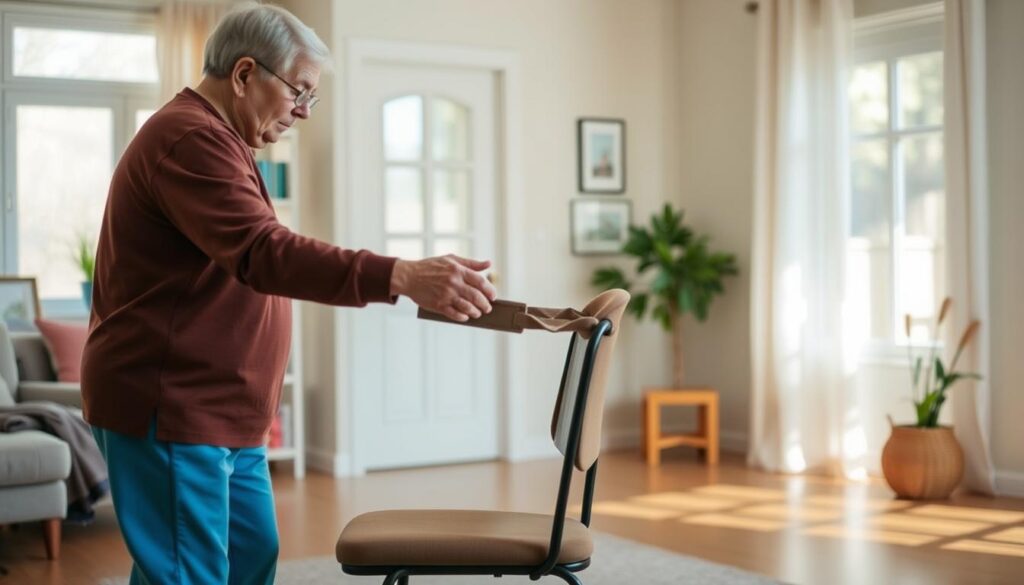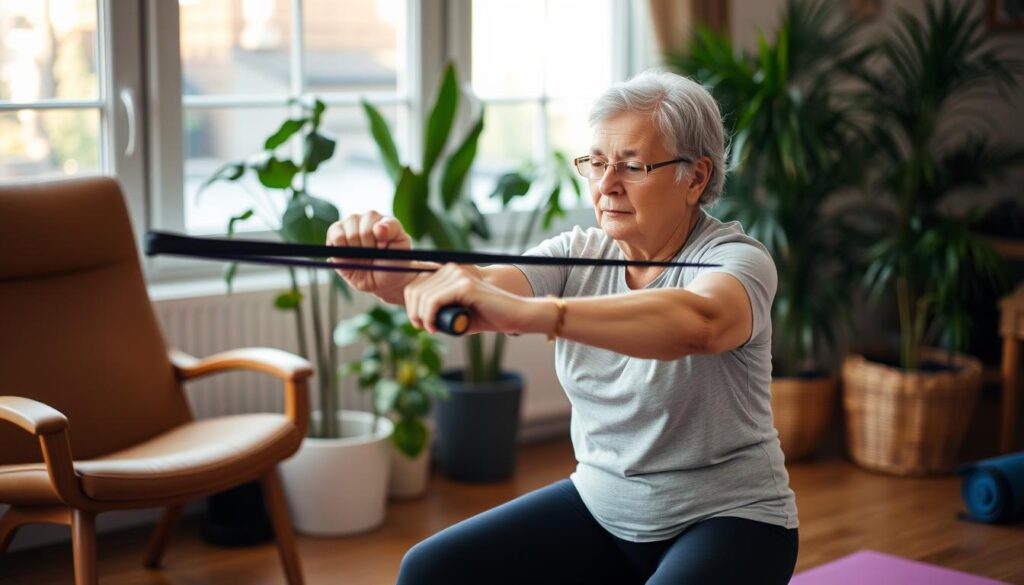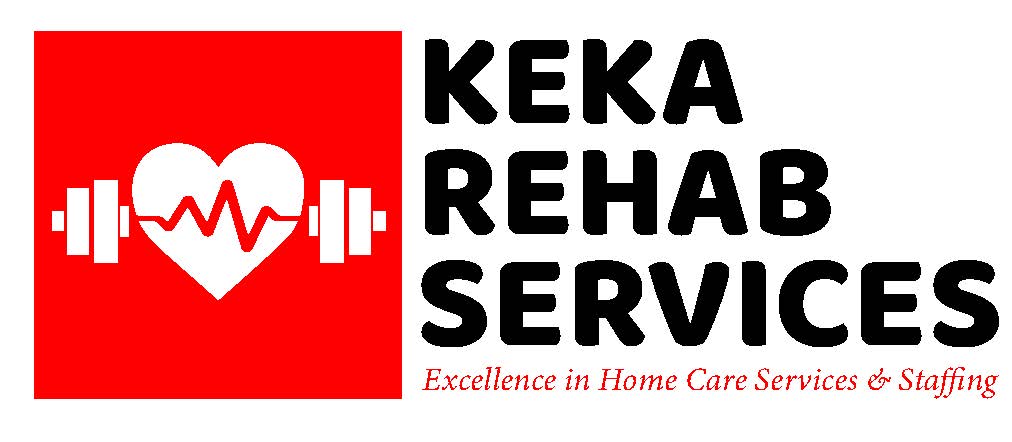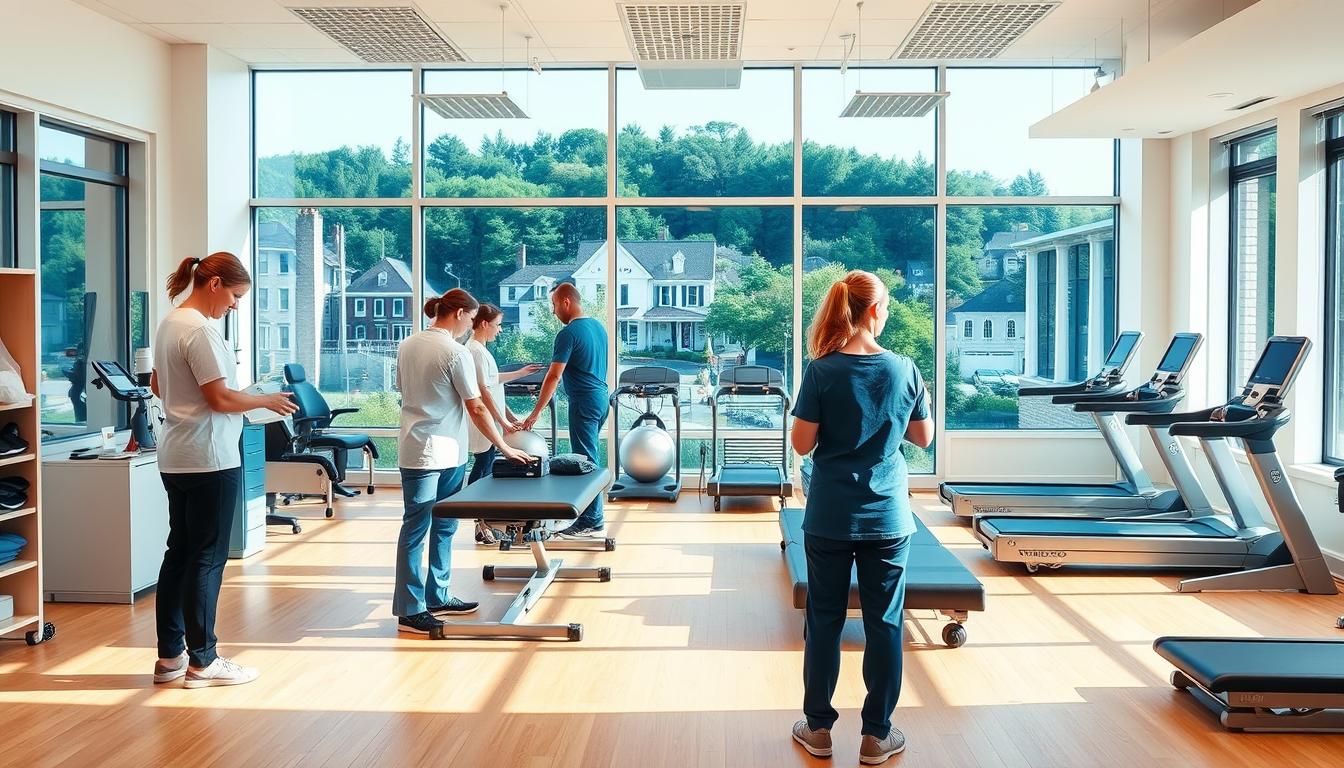As you age, staying mobile is key. In-home physical therapy for the elderly helps you regain your independence. It brings expert care right to your home.
Senior rehabilitation tackles age-related challenges head-on. It helps with chronic knee pain and vertigo, among other issues. These services can greatly improve your quality of life.
Recovering at home is ideal. It’s easier to follow your treatment plan when therapy comes to you. In fact, home-based therapy patients are 50% more likely to stick with it compared to clinic-goers.
Custom exercises using items in your house can boost strength and balance. This targeted approach reduces fall risks and improves safety. Your therapist can also suggest home modifications to support your progress.
In-home physical therapy is great for recovery or managing chronic conditions. It’s a proven way to regain strength, improve mobility, and boost confidence in daily activities.
Understanding Age-Related Physical Challenges
As you age, your body faces many physical challenges. These can affect your daily life. Elderly home care is key to keep you independent and happy. Let’s look at common conditions, their effects, and how to prevent or manage them.
Common Conditions Affecting Senior Mobility
Conditions like arthritis, osteoporosis, and balance disorders become more common with age. They can make it hard to move and do everyday tasks. Senior fitness programs can help, focusing on exercises that boost strength, balance, and flexibility.
Impact on Daily Living Activities
Age can make simple tasks like walking or personal care harder. About one-third of 70-year-olds and most 80-year-olds face mobility issues at home. This can hurt your independence and well-being, showing the need for mobility help for seniors.
Risk Factors and Prevention Strategies
Genetics, lifestyle, and wear and tear play a role in age-related challenges. To stay mobile and independent, aim for 150 minutes of moderate activity weekly. Include exercises that improve strength, stability, and balance, like getting up from a chair or walking heel-to-toe. Regular exercise, good nutrition, and early physical therapy can prevent or manage these issues well.
Benefits of in home physical therapy for Elderly
In-home physical therapy for the elderly has many benefits. It helps older adults stay independent in their daily lives. This method allows for a treatment plan that fits your exact needs.
Getting therapy at home can make you feel less stressed and more comfortable. It focuses on tasks you do every day. This makes you more independent and gets better results.
Having your family involved in therapy can make you more motivated and supported. At-home therapy lets therapists see how you move in your own space. They can spot risks and prevent falls.
Having therapy once a week can cut the chance of going back to the hospital by over 80 percent. It’s great for those who can’t move around much. They get care right in their home.
- Undivided attention from your therapist
- Higher quality of care
- Better outcomes
- Use of everyday items for exercises
In-home therapy lets you use things you already have at home for exercises. This helps you keep improving after therapy ends. Even though it might be less structured, the personal care is often worth it.
What to Expect During Home-Based Treatment Sessions
Physical therapy at home is tailored to your needs. It combines comfort with expert care, perfect for seniors. Let’s look at what happens during these sessions.
Initial Assessment Process
Your first visit includes a detailed check-up. The therapist looks at your medical history and home setup. This helps create a plan that suits your lifestyle and goals. In-home physical therapy sessions last 30 to 90 minutes and happen 1 to 3 times a week.
Treatment Plan Development
After your check-up, the therapist makes a plan just for you. It might include exercises and activities to improve balance. The goal is to boost your strength and independence. Studies show in-home therapy makes patients more motivated and likely to follow their plans.
Progress Monitoring and Adjustments
Your therapist will keep an eye on your progress. They might change your plan if you’re doing well or facing new challenges. This flexible approach helps you get the most from your therapy. In-home therapy can cut hospital readmissions and healthcare costs by 52% compared to traditional care.
Medicare often covers 100% of eligible in-home physical therapy costs. This makes it affordable for many seniors. With its tailored approach and proven benefits, in-home physical therapy helps older adults stay mobile and independent.
Specialized Equipment and Tools Used in Home Therapy
Physical therapy equipment is key for seniors to recover, move better, and stay healthy. Having your own physical therapy tools lets you control your recovery.
Portable Exercise Equipment
Resistance bands are great and affordable, targeting specific muscles. Exercise balls, or physio balls, help stretch, strengthen the core, improve posture, and balance. Stationary bikes are perfect for endurance and strength, great for hip and knee recovery after surgery.
Therapeutic Devices
Foam rollers stretch different body parts, helping with mobility. Cuff weights, worn on wrists or ankles, make exercises harder and build strength. Ice packs are vital for pain relief, following the RICE method (rest, ice, compression, elevation).
Assistive Technology
Balance pads, made from dense foam, work many muscles and boost stability. Stretching straps help with exercises and increase movement range. For neurological issues, therapy putty and devices like FitMi enhance hand strength, mobility, and coordination.
When picking mobility aids for seniors, think about value, versatility, and space at home. A virtual physical therapy check can make your home routine better, ensuring you use the right tools for your needs.
Tailored Exercise Programs for Senior Rehabilitation
Senior fitness programs are key to keeping older adults healthy and independent. In Sunnyvale, California, services for seniors aged 65 and up are available. Medicare often covers these services, making them more accessible.
Geriatric physiotherapy aims to boost mobility, balance, and physical activity. A study found that seniors in tailored exercise programs saw big improvements. They got better at walking and doing daily tasks, and felt more confident in exercising.
In-home physical therapy is great for elderly people. These programs include:
- Gentle stretching exercises
- Low-impact aerobic activities
- Resistance training
- Functional movements mimicking daily tasks
The goal is to make moving easier, reduce pain, and help with daily activities. This is vital because many seniors lose function after being in the hospital.
Sticking to home exercise can be tough, but studies show seniors do well. They usually join 65 to 86% of group sessions. At home, they do 1.5 to 3 sessions a week. This level of effort can greatly improve their health and happiness.
Balance and Fall Prevention Techniques
Falls are a big risk for seniors, with over 25 percent of adults 65 or older falling each year. Using effective exercises and balance training can help a lot.
Balance Assessment Methods
Physical therapists check balance and fall risk in older adults. They find out what needs work and create plans to prevent falls.
Environmental Safety Modifications
It’s key to make homes safer for the elderly. Remove loose rugs, clutter, and slippery floors to lower fall risks. Also, keep areas well-lit to avoid tripping on things you can’t see.
Falls often happen in bathrooms and dark bedrooms at night. So, make sure to improve these areas for safety.
Exercise-Based Prevention Strategies
Doing regular exercises can greatly improve balance and lower fall risks. Focus on strengthening, improving balance, coordination, and flexibility. For example, doing sit-to-stand exercises 10 times, twice a day, is recommended.

Balance exercises are key to preventing falls. Try to hold each position for 10 seconds, then 30 seconds, with five reps twice a day. Always check with a doctor or physical therapist before starting new exercises, and exercise with a friend at home for safety.
By adding these balance and fall prevention techniques to daily routines, seniors can stay independent and lower fall injury risks. Remember, investing in fall prevention helps seniors stay independent.
Post-Operative Care and Recovery at Home
After surgery, in-home physical therapy for seniors is key for a smooth recovery. It focuses on care plans made just for each person, making recovery easier.
Home health care is important in keeping patients out of the hospital after surgery. It helps by teaching patients and fixing safety issues like falls and medication mistakes. Skilled nurses also check on medications and teach patients how to manage their recovery at home.
In-home physical therapy for seniors includes:
- Wound care and dressing changes
- Medication management
- Customized physical therapy sessions
- Nutritional guidance
Physical therapy is a big part of post-operative care. It helps patients get stronger, move better, and feel less pain. Therapists work with patients to make care plans that fit their needs and what they want.
Good nutrition is also key for healing. After surgery, patients often need more calories, protein, and healthy fats. Foods like lean meats, plant-based proteins, low-fat dairy, avocados, nuts, and olive oil are good choices. These foods help with healing and recovery.
Choosing in-home physical therapy for seniors means getting a full care package. This service helps you recover well in your own home, making the process smoother and more comfortable.
Pain Management and Mobility Enhancement
Physical therapy is key for seniors with chronic pain and those looking to improve mobility. Home sessions are tailored to meet individual needs, lasting about six to eight weeks. These sessions aim to lessen pain and boost overall function.
Non-Pharmacological Pain Control Methods
Chronic pain hits over 50% of older adults, with 70% feeling pain in more than one spot. Therapists use non-drug methods to help:
- Manual therapy
- Ultrasound treatments
- Electrical stimulation
- Heat and cold therapy
These methods help manage pain without the side effects of drugs.
Therapeutic Movement Techniques
Gentle exercises and stretches are at the heart of therapeutic movement. They aim to:
- Increase flexibility
- Improve joint mobility
- Strengthen muscles
For those with osteoarthritis, physical therapy can lessen pain and increase range of motion. This makes daily activities easier.
Progressive Mobility Training
This method slowly increases activity levels to boost mobility. It’s great for preventing falls, as physical therapy can cut falls by up to 50% through programs like the Otago exercise regimen. The training includes:
- Balance exercises
- Strength training
- Gait improvement
In-home physical therapy helps seniors regain independence and improve their quality of life by addressing pain and improving mobility.
Building Strength and Endurance Safely
Safe exercises are key for seniors to stay healthy and independent. Senior strength training helps improve muscle strength, balance, and fitness. These programs are made for older adults‘ unique needs.
Geriatric physical therapy offers exercises tailored for seniors. These include strength training, balance exercises, and flexibility routines. Cardio activities boost stamina, and functional training helps with daily tasks.

Studies show regular exercise can cut fall risk by up to 32% for the elderly. In fact, 63% of seniors doing strength exercises said they felt better balanced. This shows how important exercise is for older adults.
Personalized exercise plans are vital for senior strength training. Physical therapists make programs that get gradually harder. This keeps seniors safe while helping them get stronger and more energetic.
The results are impressive. 78% of seniors felt more energetic, and 66% said they felt healthier after exercising regularly. For those in assisted living, fitness activities cut heart disease risk by 45% and diabetes by 27%.
It’s never too late to start exercising. With the right guidance and safe exercises, seniors can boost their strength, balance, and life quality. Talk to a geriatric physical therapist to start your path to better health and independence.
The Role of Caregivers in Physical Therapy Success
Caregivers are key to the success of in-home physical therapy for seniors. Family support can greatly improve rehabilitation efforts. Let’s see how caregivers help in the physical therapy process.
Caregiver Training and Education
Physical therapists work with families to support elderly patients. They teach caregivers how to help with exercises and daily tasks. This training ensures seniors get consistent care between sessions.
Supporting Daily Exercise Routines
Caregivers are vital in keeping care consistent. They help seniors do their exercises, motivate them, and ensure safety. This support is essential for improving mobility and independence.
Communication with Healthcare Team
Good communication between caregivers, patients, and the healthcare team is critical. Caregivers share important feedback with therapists about the senior’s progress. This helps therapists make necessary changes to treatment plans for the best results.
Studies show that seniors with strong family support do better in physical therapy. By creating a supportive home environment and participating in rehabilitation, caregivers can greatly improve in-home physical therapy for their elderly loved ones.
Conclusion
In-home physical therapy is a game-changer for elderly patients. It boosts their ability to move around and live independently. This care is given right in their homes, leading to better results than going to a clinic.
Seniors save time and energy by not having to travel for therapy. In fact, 85% of people prefer therapy at home. It also makes them less likely to fall, with a 30% drop in falls in the first three months.
But it’s not just about physical health. It also helps seniors feel less lonely. A therapist’s visit can make them feel more confident and happy as they get better. For those with long-term conditions like arthritis, it helps them stick to their treatment plans by 40%.
In-home therapy improves seniors’ lives in many ways. It helps with exercises, managing pain, and after surgery care. It’s a key part of helping seniors live better, more independent lives.


